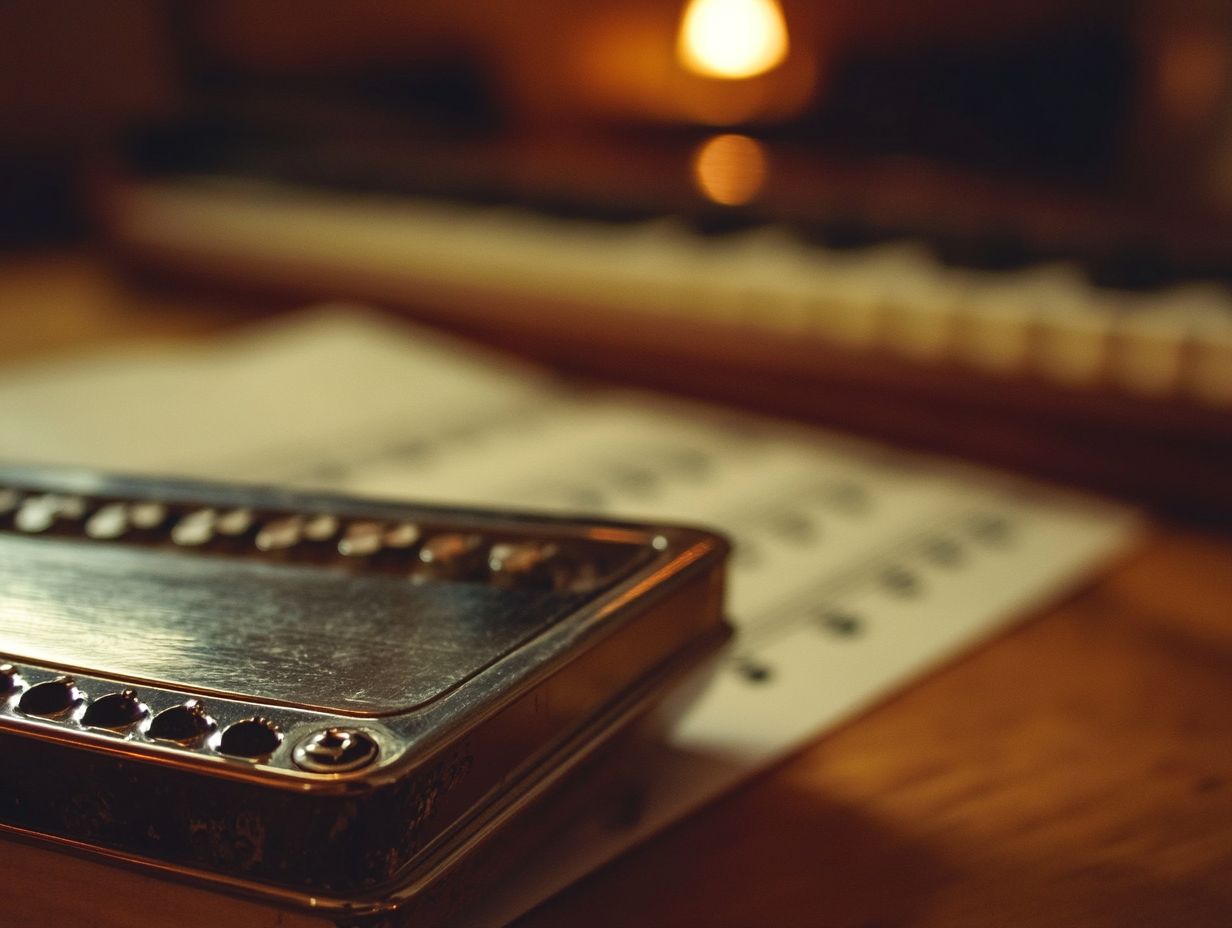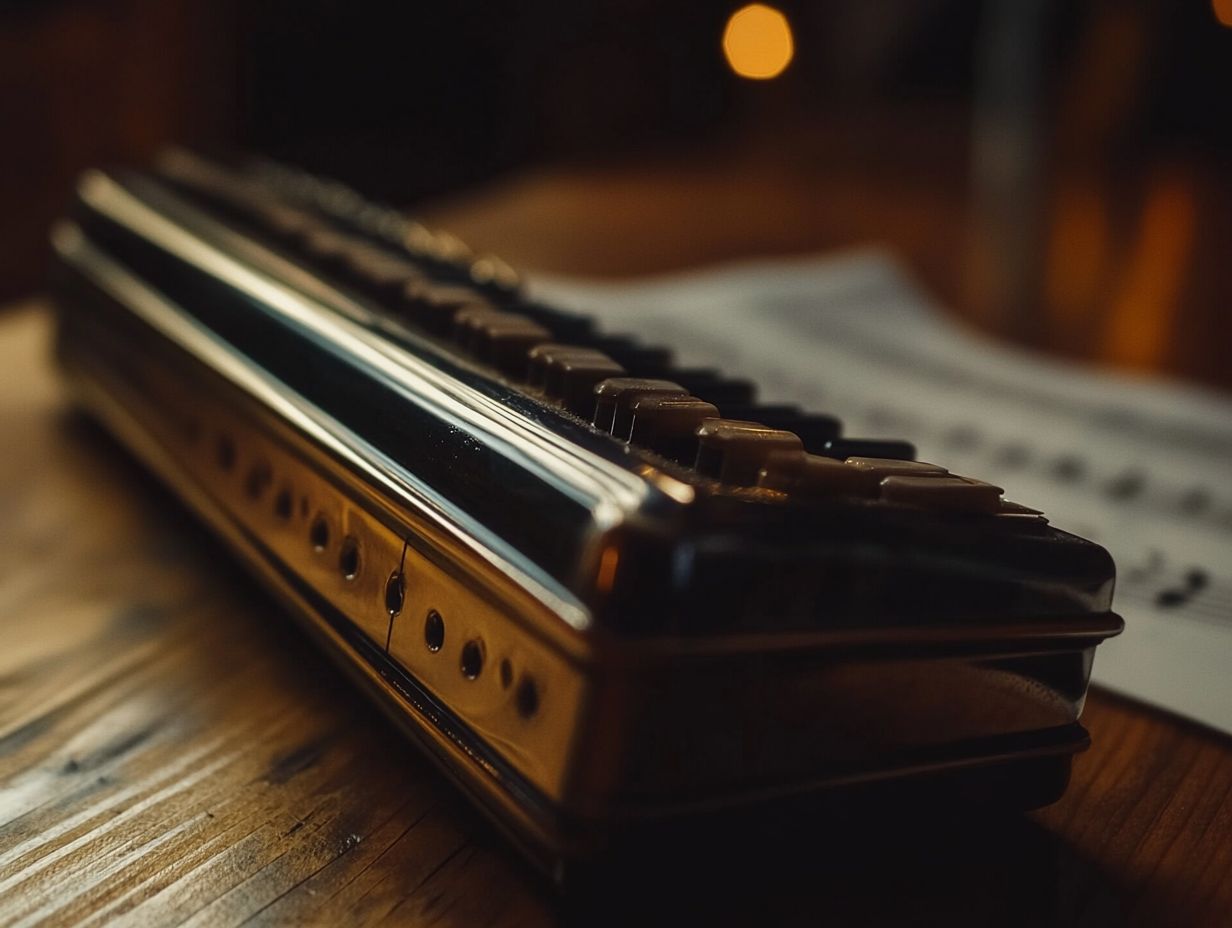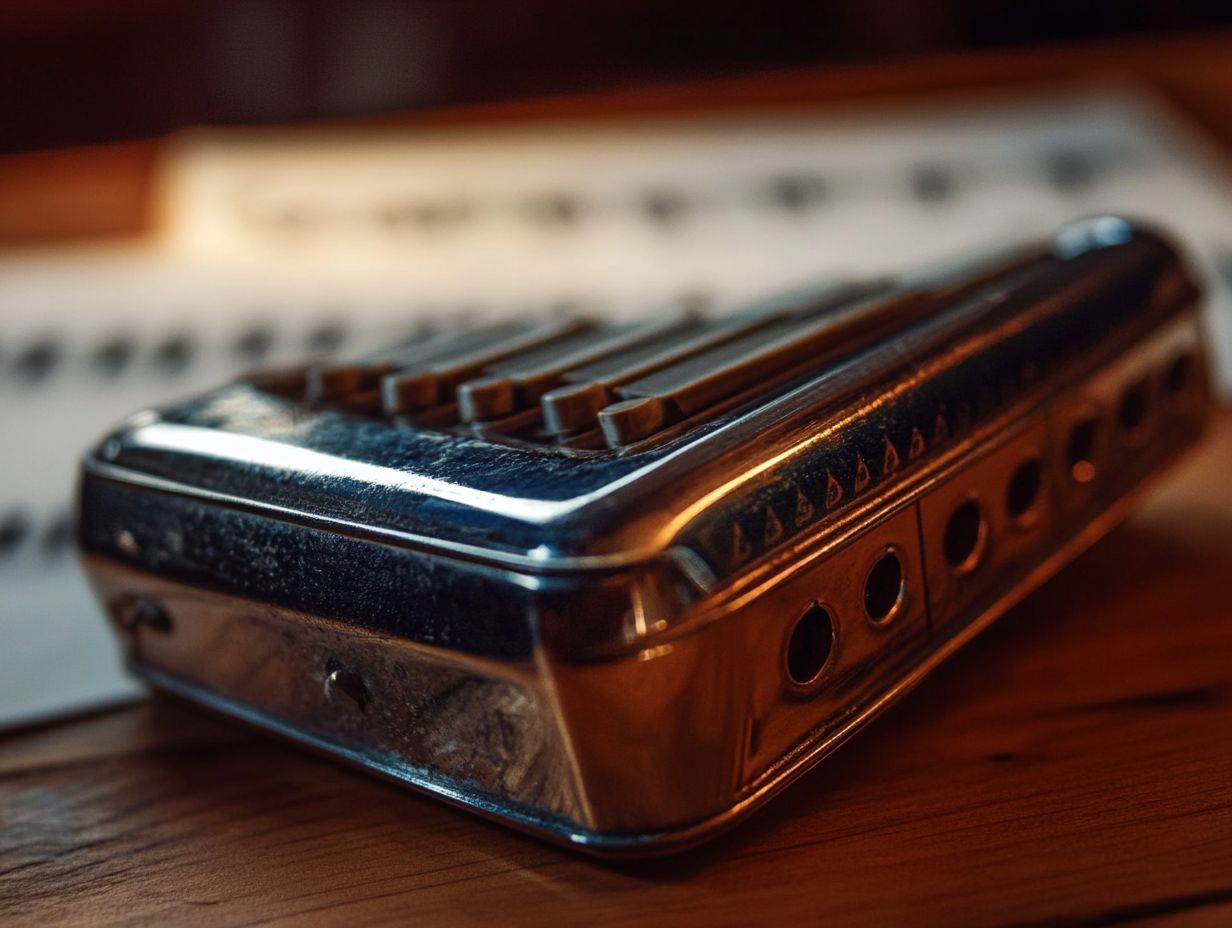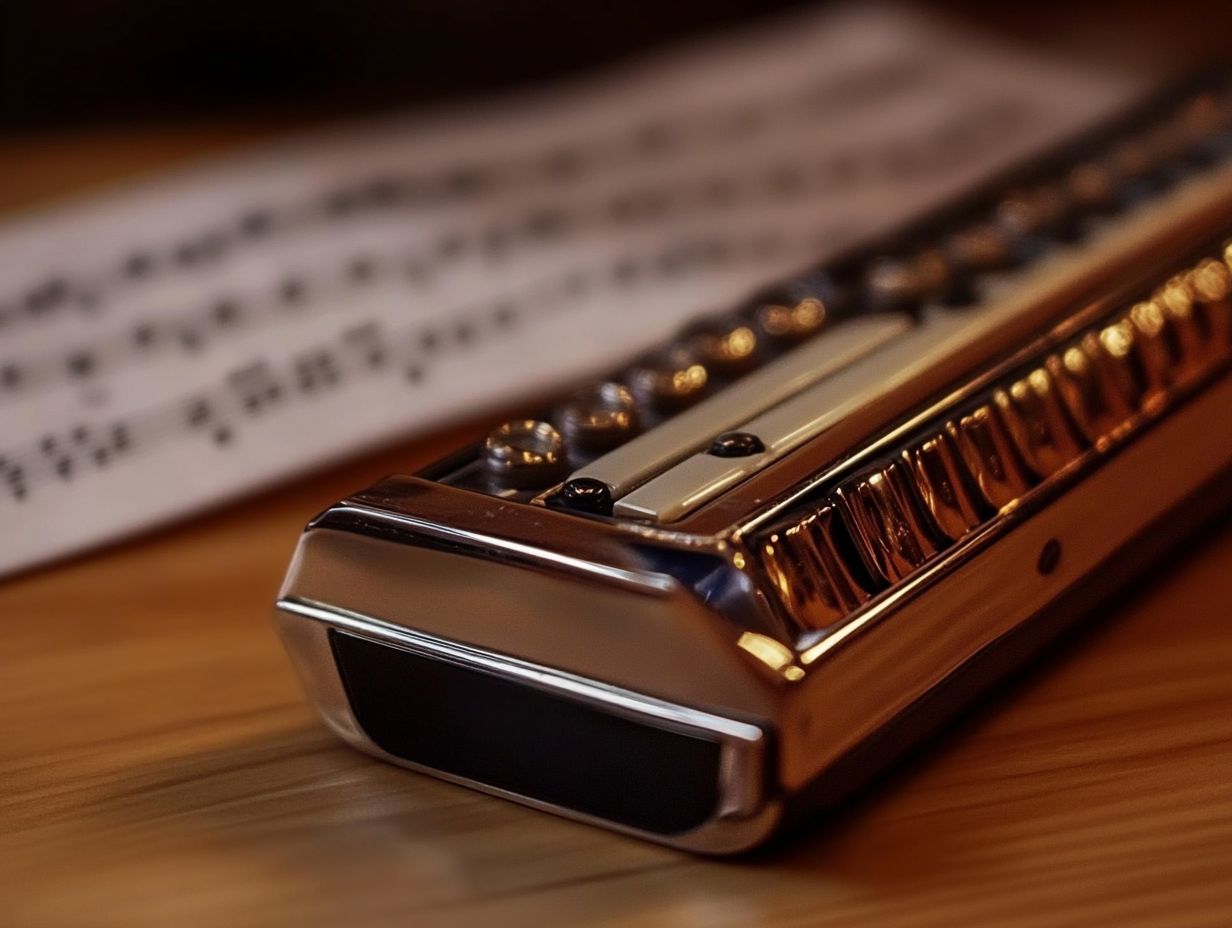The harmonica is a small musical instrument known for its big sound. With a rich history, it is utilized across a wide variety of musical genres. Its intriguing origins, complex anatomy, and evolution over the years are well documented.
This article explores the different types of harmonicas and their unique applications, delves into essential playing techniques, and highlights iconic songs that feature captivating harmonica solos.
Additionally, it outlines the physical and mental benefits of playing the instrument, along with practical tips for beginners who wish to embark on their musical journey. Whether you are a seasoned musician or a curious newcomer, there is something here for everyone to enjoy.
Contents
The History of the Harmonica

The history of the harmonica dates back to the early 19th century, and it has since evolved into a highly regarded portable instrument. The harmonica has had a significant impact on a wide range of music genres, including blues, folk music, jazz, rock, and pop.
Its unique sound is produced through vibrating reeds and breath control, making it a popular choice among musicians worldwide. This underscores the cultural significance and craftsmanship of the harmonica across various musical expressions.
Origins and Evolution
The harmonica has its roots in ancient instruments, but the modern diatonic harmonica emerged in the early 1800s, followed by the chromatic harmonica. Both have significantly contributed to music theory and practice in various ways.
These instruments possess unique tonal and playing characteristics that cater to different musical genres. The diatonic harmonica is commonly used in folk, blues, and rock music, and it is designed to enable players to easily bend notes, creating the expressive sounds characteristic of these genres.
In contrast, the chromatic harmonica features a button-activated slide that allows musicians to access a wider range of notes, making it a popular choice in jazz and classical compositions.
As musicians have experimented with and evolved their playing styles over the decades, new types of harmonicas, such as the tremolo and orchestral harmonica, have emerged, further expanding the instrument’s reach and versatility within the musical landscape.
The Anatomy of a Harmonica
The anatomy of a harmonica encompasses its various parts, including the reeds, comb, and cover plate. These components contribute to the instrument’s distinctive sound dynamics and enhance its playability as a mouth organ.
Parts and Functions

The harmonica is composed of three main parts: reeds, a comb, and cover plates, each serving a specific function in sound and melody production. Understanding these components is essential for effective playing.
Reeds are thin strips of metal that vibrate to create sound. The pitch of the sound produced depends on the length and thickness of each reed; shorter and thicker reeds generate higher pitches, while longer and slimmer reeds produce lower pitches.
Comb serves as the main body of the harmonica, providing the instrument’s structure and housing the reeds. The design of the comb can influence sound quality by affecting the airflow to the reeds.
Cover Plates protect the reeds from physical damage and dirt while helping to direct the sound outward. The design and material of the cover plates can also impact the volume and tonal quality of the harmonica.
Additionally, harmonica accessories such as microphones, amplifiers, and custom cases can enhance performance by improving sound amplification and offering extra protection during transport.
Types of Harmonicas
There are several types of harmonicas, including the diatonic harmonica, which is the most common type used in blues and folk music, and the chromatic harmonica, favored in jazz and classical music. Both types are available in various keys to accommodate different musical styles.
Different Variations and Uses
Harmonicas come in various types, including tremolo harmonicas and orchestral harmonicas, each designed for different genres and musical performances, ranging from solo acts to busking in various venues.
Each type of harmonica serves distinct purposes in different genres; for instance, the diatonic harmonica is commonly used by blues and rock musicians for its raw, expressive sound, while chromatic harmonicas are favored in jazz for their chromatic flexibility.
In folk music, the harmonica contributes a rustic flavor that enhances storytelling and adds emotional depth to live performances.
Playing Techniques

Essential skills for mastering harmonica techniques include breath control and improvisation. These skills enable musicians to explore a wide range of rhythmic patterns and sound dynamics, which are essential for effective musical expression.
Breathing and Tonguing Techniques
Breathing and tonguing techniques are essential for harmonica players because they significantly influence sound waves. These techniques necessitate careful breath control and articulation, enabling musicians to produce clear notes and expressive melodies.
Popular Songs Featuring the Harmonica
Many popular songs have incorporated the harmonica, showcasing iconic solos that highlight the instrument’s unique sound and versatility.
The harmonica contributes significantly to musical expression and the songwriting process across a wide range of genres, including blues, rock, and pop.
Iconic Harmonica Solos

Some of the most iconic harmonica solos in music history have been performed by the greatest artists of their time, creating unforgettable moments in live performances and leaving a lasting legacy for future generations of harmonica players.
These performances have not only showcased the technical skills of artists like Bob Dylan and Little Walter but have also profoundly moved listeners. The melodies produced on the harmonica possess the power to transport audiences to different times and places, evoking feelings of nostalgia, joy, and even sadness.
Fans often recall how a single note from a virtuoso can resonate deeply, creating an experience that transcends mere listening to music.
Benefits of Playing the Harmonica
The harmonica offers several benefits, including improved physical health through enhanced breath control, as well as mental health advantages such as stress relief and emotional expression.
This versatility makes it an effective tool in music therapy.
Physical and Mental Health Benefits
Playing the harmonica offers numerous physical and mental health benefits. Physically, it can lead to increased lung capacity and improved breath control. Mentally, it enhances creativity, fosters an emotional connection to music, and contributes to a sense of well-being and relaxation.
Engaging with this small instrument can effectively relieve stress, as the act of producing sound encourages mindfulness and promotes a meditative state.
Additionally, playing the harmonica improves motor skills and hand-eye coordination, while also enhancing cognitive function through the learning of music reading and rhythmic engagement. Furthermore, harmonica playing can strengthen social connections through jam sessions and group lessons, facilitating friendships and social bonding.
Thus, the harmonica transcends its role as a mere musical instrument, becoming a valuable tool for enhancing both physical and emotional health.
Getting Started with the Harmonica
The harmonica is one of the easiest instruments to learn and play. It offers a low cost of entry, and aspiring musicians can easily access tips, lessons, downloadable apps, and online communities dedicated to harmonica playing.
This accessibility not only makes the harmonica a great choice for musicians of all ages but also simplifies the learning process for the instrument itself.
Tips for Beginners
Establishing proper practice schedules and setting realistic challenges for beginner harmonica players can enhance their learning, help them progress to harmonica contests, and accelerate their skill development.
First, beginners should break their practice sessions into smaller segments that focus on various techniques, such as breathing exercises, note bending, and scales. This segmented approach makes it easier for beginners to grasp the fundamentals while also gaining a deeper understanding of the instrument’s nuances.
Setting specific challenges, such as perfectly playing a favorite song or improvising a melody, can help maintain motivation and provide a sense of accomplishment. Seeking advice from more experienced players can also be beneficial, as they can guide you through challenging parts, boost your confidence, and foster a sense of community that enhances the overall joy of harmonica playing, ultimately preparing you for competitions.
